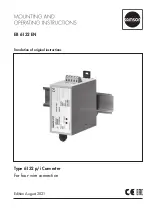42
First came analog synthesizers, then came the digital revolution, at which time
synthesizers were starting to come under digital control. To allow them to
communicate with one another, in 1983 several musical instrument manufacturers
agreed upon a standard: the Multiple Instrument Digital Interface (MIDI).
MIDI is a control language that says things like “play a C3 at xxx velocity, now turn on
the sustain pedal, now turn it off, now stop playing that C3, etc.”
(Velocity is a measure
of how fast a MIDI key is played, and usually that determines how loud a note is.)
It’s up to the receiving device how to interpret these messages, so you could record a
MIDI part (in sequencing software, meaning MIDI and audio recording/editing software)
from one keyboard set to a piano sound. Then you could play it back on a harp sound,
send it to a different MIDI instrument playing a guitar sound, transpose the notes, play
them back faster, move them around, make them louder or softer, copy and paste
them, and so on. MIDI is not sound, it is “performance”
instructions that receiving
instruments and other devices may use to play sounds (or to do anything else they
want, such as operate lights).
Computers don’t accept MIDI plugs –
they need a MIDI interface that plugs into one of
their USB ports. The four pairs of MIDI 5-pin DIN ports on your iConnectMIDI
4+
are the
same ports found on every piece of MIDI equipment from 1983 through today,
although the iConnectMIDI4
+
has some very clever processing and routing tricks up its
sleeve.
Digital audio, on the other hand, is the actual sound, not the instructions for playing it.
If you sing or play an instrument into a microphone, the sound waves in the air are
moving a diaphragm that varies the strength of an electromagnet it’s attached to (or
varies the capacitance between two membranes) converting the sound to electricity.
When it’s recorded –
digitized - that sound is measured 44,100 times a second at the
standard CD sampling rate; when it’s played back, the process is reversed: the
recorded numbers are used to create a voltage that ultimately drives your speakers,
which move the air so you hear the recording.
Today even an iPhone has enough computing power to run synthesizers that exist only
in software (after all, a digital synthesizer is simply a computer dedicated to one task).
When you use MIDI to trigger a software instrument, the sound is being created
digitally and it’s not necessary to digitize it –
thus you don’t need a standard audio
interface with analog-to-digital conversion for recording and digital-to-analog
conversion for playback on every computing device in your set-up.
So the iConnectMIDI4
+
routes audio that exists inside a computer device (meaning a
computer or a supported iOS device) between two machines. The audio can come
from software instruments and/or it can come from recorded sounds that are on the
Appendix: MIDI and audio basics
Summary of Contents for iConnectMIDI4+
Page 1: ... OWNER S MANUAL ...
Page 7: ...7 The iConnectMIDI4 hardware ...
Page 13: ...13 ...
Page 24: ...24 ...


















